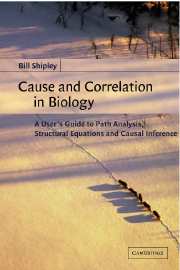 Cause and Correlation in Biology
Cause and Correlation in Biology Book contents
- Frontmatter
- Contents
- Preface
- 1 Preliminaries
- 2 From cause to correlation and back
- 3 Sewall Wright, path analysis and d-separation
- 4 Path analysis and maximum likelihood
- 5 Measurement error and latent variables
- 6 The structural equations model
- 7 Nested models and multilevel models
- 8 Exploration, discovery and equivalence
- Appendix
- References
- Index
7 - Nested models and multilevel models
Published online by Cambridge University Press: 10 December 2009
- Frontmatter
- Contents
- Preface
- 1 Preliminaries
- 2 From cause to correlation and back
- 3 Sewall Wright, path analysis and d-separation
- 4 Path analysis and maximum likelihood
- 5 Measurement error and latent variables
- 6 The structural equations model
- 7 Nested models and multilevel models
- 8 Exploration, discovery and equivalence
- Appendix
- References
- Index
Summary
Like successful politicians, good statistical models must be able to lie without getting caught. For instance, no series of observations from nature are really normally distributed. The normal distribution is just a useful abstraction – a myth – that makes life bearable. In constructing statistical models we pretend that the normal distribution is real and then check to ensure that our data do not deviate from it so much that the myth becomes a fairy tale. In Chapter 6 we saw how far we could stretch the truth about the distributional properties of our data before our data called us a liar. The goal of this chapter is to describe how SEM can deal with two other statistical myths that people often relate with respect to their data.
Two important assumptions made by all of the models that we have studied up to now is that the observations in our data sets are (i) independent draws generated by (ii) the same causal process. Consider first the assumption of causal homogeneity. It is easy to imagine cases in which different groups of observations might be generated by partially different causal processes. For instance, a behavioural ecologist studying a series of variables related to aggression and social dominance in primates would not necessarily want to combine together the observations from males and females, since it is possible that the behavioural responses of males and females are generated by different causal stimuli.
Information
- Type
- Chapter
- Information
- Cause and Correlation in BiologyA User's Guide to Path Analysis, Structural Equations and Causal Inference, pp. 199 - 236Publisher: Cambridge University PressPrint publication year: 2000